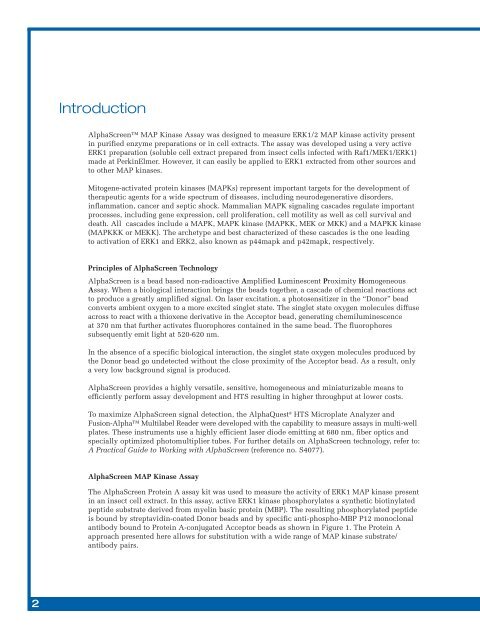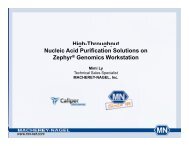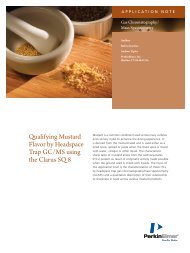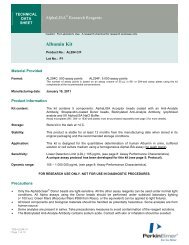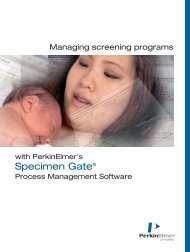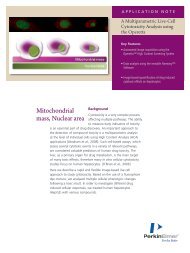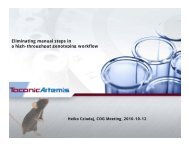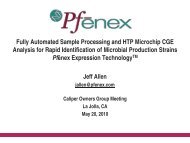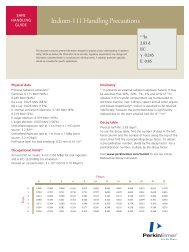AlphaScreen⢠MAP Kinase Assay - PerkinElmer
AlphaScreen⢠MAP Kinase Assay - PerkinElmer
AlphaScreen⢠MAP Kinase Assay - PerkinElmer
You also want an ePaper? Increase the reach of your titles
YUMPU automatically turns print PDFs into web optimized ePapers that Google loves.
Introduction<br />
AlphaScreen <strong>MAP</strong> <strong>Kinase</strong> <strong>Assay</strong> was designed to measure ERK1/2 <strong>MAP</strong> kinase activity present<br />
in purified enzyme preparations or in cell extracts. The assay was developed using a very active<br />
ERK1 preparation (soluble cell extract prepared from insect cells infected with Raf1/MEK1/ERK1)<br />
made at <strong>PerkinElmer</strong>. However, it can easily be applied to ERK1 extracted from other sources and<br />
to other <strong>MAP</strong> kinases.<br />
Mitogene-activated protein kinases (<strong>MAP</strong>Ks) represent important targets for the development of<br />
therapeutic agents for a wide spectrum of diseases, including neurodegenerative disorders,<br />
inflammation, cancer and septic shock. Mammalian <strong>MAP</strong>K signaling cascades regulate important<br />
processes, including gene expression, cell proliferation, cell motility as well as cell survival and<br />
death. All cascades include a <strong>MAP</strong>K, <strong>MAP</strong>K kinase (<strong>MAP</strong>KK, MEK or MKK) and a <strong>MAP</strong>KK kinase<br />
(<strong>MAP</strong>KKK or MEKK). The archetype and best characterized of these cascades is the one leading<br />
to activation of ERK1 and ERK2, also known as p44mapk and p42mapk, respectively.<br />
Principles of AlphaScreen Technology<br />
AlphaScreen is a bead based non-radioactive Amplified Luminescent Proximity Homogeneous<br />
<strong>Assay</strong>. When a biological interaction brings the beads together, a cascade of chemical reactions act<br />
to produce a greatly amplified signal. On laser excitation, a photosensitizer in the “Donor” bead<br />
converts ambient oxygen to a more excited singlet state. The singlet state oxygen molecules diffuse<br />
across to react with a thioxene derivative in the Acceptor bead, generating chemiluminescence<br />
at 370 nm that further activates fluorophores contained in the same bead. The fluorophores<br />
subsequently emit light at 520-620 nm.<br />
In the absence of a specific biological interaction, the singlet state oxygen molecules produced by<br />
the Donor bead go undetected without the close proximity of the Acceptor bead. As a result, only<br />
a very low background signal is produced.<br />
AlphaScreen provides a highly versatile, sensitive, homogeneous and miniaturizable means to<br />
efficiently perform assay development and HTS resulting in higher throughput at lower costs.<br />
To maximize AlphaScreen signal detection, the AlphaQuest ® HTS Microplate Analyzer and<br />
Fusion-Alpha Multilabel Reader were developed with the capability to measure assays in multi-well<br />
plates. These instruments use a highly efficient laser diode emitting at 680 nm, fiber optics and<br />
specially optimized photomultiplier tubes. For further details on AlphaScreen technology, refer to:<br />
A Practical Guide to Working with AlphaScreen (reference no. S4077).<br />
AlphaScreen <strong>MAP</strong> <strong>Kinase</strong> <strong>Assay</strong><br />
The AlphaScreen Protein A assay kit was used to measure the activity of ERK1 <strong>MAP</strong> kinase present<br />
in an insect cell extract. In this assay, active ERK1 kinase phosphorylates a synthetic biotinylated<br />
peptide substrate derived from myelin basic protein (MBP). The resulting phosphorylated peptide<br />
is bound by streptavidin-coated Donor beads and by specific anti-phospho-MBP P12 monoclonal<br />
antibody bound to Protein A-conjugated Acceptor beads as shown in Figure 1. The Protein A<br />
approach presented here allows for substitution with a wide range of <strong>MAP</strong> kinase substrate/<br />
antibody pairs.<br />
2


